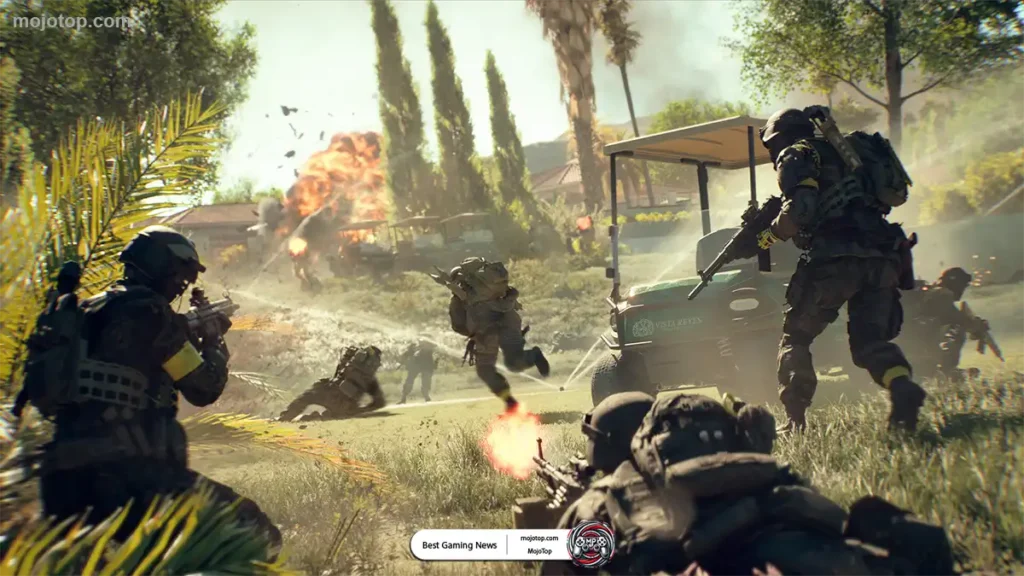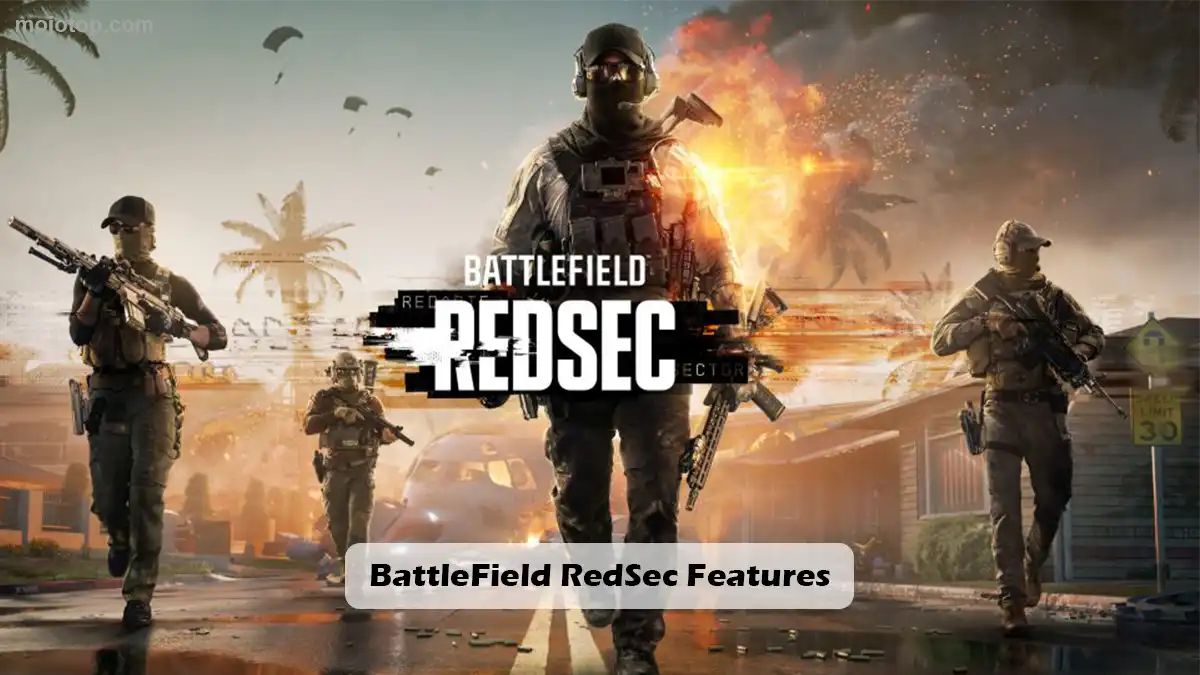Battlefield REDSEC: 3 Key Features You Should Know
A focused review of Battlefield REDSEC gameplay, graphics, and story breaking down how this new Battlefield entry redefines tactical combat.
Next-Gen Presentation You Can Feel
REDSEC leans on high-end features like 4K targets, HDR, spatial audio, and steady 60-plus FPS to sell the chaos: debris clouds hang after wall breaches, foliage whips in shockwaves, and tracer fire carves through haze. These presentation pillars—paired with Battlefield’s physics-driven destruction deliver that “you-are-there” vibe in firefights and vehicle pushes. On PC, granular graphics settings (and modern upscaling options) let you balance visual fidelity and latency for competitive play.
Destruction, Weather, and Dynamic Combat
What makes Battlefield REDSEC gameplay feel different is how the battlefield evolves. Breaching a townhouse to cut sightlines or leveling cover with tank shells meaningfully changes routes and risk. Large playspaces and shifting weather amplify tension: sudden low-vis squalls force close-quarters rotations; clearing skies invite long-range picks. It’s classic Battlefield sandbox design, retooled for a battle-royale tempo with 100-player intensity.
Platforms and Competitive Consistency
By focusing on PS5, Xbox Series X|S, and PC—and skipping last-gen—REDSEC standardizes frame pacing and memory budgets so weapons feel snappier, hit-reg is more reliable, and traversal stays fluid during peak server load. On console you can disable cross-play if you want a narrower skill pool; on PC, dialing in frame-time, DLSS/FSR, and reflex features helps maintain responsiveness in hot drops and end-circles.
Progression That Feels Cohesive
Immersion also comes from continuity. A single EA ID carries your account level, cosmetics, and challenge tracks between Battlefield 6 and REDSEC; leveling in one reflects in the other. That consistent reward loop keeps you engaged across modes without fragmenting your identity or friends list.

Strategic Team Mechanics
In Battlefield REDSEC, the team-based systems push beyond typical battle-royale mechanics to emphasise cooperation, class roles, and strategic squad play. The way squads coordinate—choosing classes, executing contracts, reviving teammates, and leveraging vehicles—significantly shapes the quality of Battlefield REDSEC gameplay. The following detailed breakdown explains how these strategic team mechanics work and why they matter.
Class Roles and Squad Synergy
One of the core features of Battlefield REDSEC is its four-class system: Assault, Engineer, Support, and Recon. Each class brings specific tools, gadgets, and strengths that meaningfully impact squad performance. For example, the Support class’s Supply Bag allows squadmates to replenish ammo mid-combat, which reinforces sustained fighting rather than hit-and-run tactics.
When squads compose all four classes, they gain maximal flexibility: Engineers can open vaults or deal with vehicles, Recon can provide intel or long-range coverage, Assault leads offensive pushes, and Support keeps the team stocked and revived. This balance enables more cohesive and strategic approaches rather than isolated solo kills. According to the new player guide, “WORK WITH YOUR TEAM… share enemy locations and precious high-value items, and remember to revive them whenever it is clear to do so.”
Contracts, Missions and Shared Objectives
Beyond simply eliminating the enemy, Battlefield REDSEC gameplay integrates mission-based objectives into squad flow. Teams can accept Contracts—such as securing weapon caches or decrypting data drives—that reward upgrades, intel, or vehicle access. These mechanics encourage squads to coordinate who takes the objective, who provides cover, and who secures extraction zones.
The objective-driven structure adds a layer of strategic depth: when squads execute Contracts together, they gain tactical advantages—better weapons, vehicle pickups, or map intel—that carry them into later circles. This design keeps team dynamics active throughout the match, rather than devolving into chaotic free-for-all gunfights. As one tip article notes: “Play the objective… focus on the actions that will score your team the most points, and don’t worry as much about that K/D ratio.”
Revive, Redeploy and Squad-Centered Survival
Survivability in Battlefield REDSEC is intimately tied to squad mechanics. When a player is downed, teammates can use Redeploy Towers or specific squad tools to bring them back into the fight—this fosters a stronger emphasis on team positioning, covering revives, and tactical retreats.
By designing revive and redeploy systems around squads rather than lone wolves, Battlefield REDSEC gameplay rewards players who move, support, and strategize as a unit. It reinforces the idea that your match-winning potential grows when your squad behaves like a cohesive force rather than four independent players.
Vehicle Warfare and Team Tactics
Another strategic layer in Battlefield REDSEC is vehicle deployment. When squads coordinate to open vaults, access keycards, or commandeer tanks and other vehicles, the pacing shifts from pure infantry engagements to combined-arms warfare. Squads must assign roles: who drives, who mans the weapons, who scouts ahead. One guide recommends: “Save tanks for the end… A tank at the final circle is nearly unstoppable unless you’re up against a team full of Engineers with anti-vehicle equipment.”
This adds variety to the team mechanics: squads that excel in coordination across infantry and vehicles gain a strategic edge in Battlefield REDSEC gameplay.
Why These Mechanics Matter for Ranking and Engagement
These strategic team mechanics class synergy, mission contracts, squad-revives, and vehicle coordination give Battlefield REDSEC a more layered and tactical identity compared to standard battle-royale titles. They help maintain engagement, challenge players beyond killing, and reward cooperation. Reviews emphasise that though REDSEC may face comparisons to other BR games, its emphasis on team roles and objectives helps it preserve the spirit of the Battlefield franchise.
For content creators, competitive squads, or casual players who care about squad coordination and objective-based play, these features make Battlefield REDSEC gameplay stand out. The strategic dimension encourages deeper playstyles, consistent progression, and high replay value.
Advanced Visuals and Audio Powering Battlefield REDSEC Gameplay
In Battlefield REDSEC, the visual fidelity and sound design combine to elevate the experience of Battlefield REDSEC gameplay into a truly immersive performance. From next-gen lighting and destructible environments to spatial sound, the game embraces high-end presentation, ensuring that players on supported platforms feel engaged—whether on PC or console.
Next-Gen Graphics, Destruction & Environment
On the graphical front, Battlefield REDSEC supports 4K Ultra HD resolution, HDR10, and targets frame rates of 60 fps or more on platform versions such as Xbox Series X and PlayStation 5. The map environments are highly detailed and built around the massive sandbox of “Fort Lyndon,” a destructible war zone where players can reshape cover, collapse walls and take advantage of environmental destruction as a tactical tool.
These advanced visuals mean that during Battlefield REDSEC gameplay, material textures, lighting effects, shadows and surface details all contribute to realistic immersion. Whether it’s shrapnel scattering, glass cracking under mortar fire, or vegetation reacting to explosions, each visual element supports the game’s atmosphere of large-scale warfare.
High-Fidelity Audio & Spatial Awareness
In parallel with the visuals, Battlefield REDSEC gameplay benefits greatly from high-quality audio systems. The Xbox Store listing mentions Spatial Sound, Dolby Atmos and DTS:X among the supported technologies. These audio features provide depth and directionality—for example, the rumble of a tank shell approaching from behind, or the snap of glass overhead, become audible cues rather than background effects.
This level of sound design enhances tactical awareness, giving squads a richer ability to interpret enemy position, vehicle movement, or nearby engagements. When visuals and audio integrate smoothly, the overall presentation supports better gameplay decisions rather than mere spectacle.
Why This Matters for Gameplay
-
Immersion fuels decision-making: when visuals and audio convey environment and threat accurately, squads can coordinate effectively during Battlefield REDSEC gameplay.
-
Destructible terrain becomes a tactical layer: advanced destruction systems allow players to change the battlefield in real-time, making cover unreliable and forcing adaptation.
-
Sound cues elevate team mechanics: hearing footsteps, vehicle engines, gunfire or debris gives teams an edge, supporting the strategic team mechanics of the game.
-
Consistency across platforms ensures fair competitive balance: because the game is tuned for modern hardware, players on PC and console receive similar levels of performance, which reinforces skill and strategy over hardware advantage.

